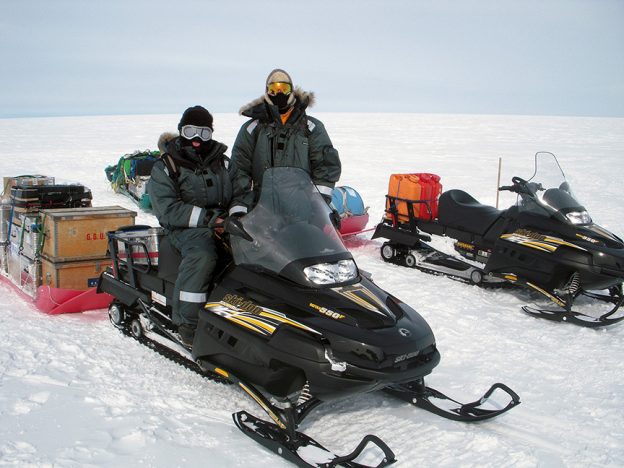The FirnCover science team arrived at the EKT site approximately 100 km (~62 mi) NE of DYE 2 Sunday afternoon. The snowmobile traverse was fairly uneventful with the exception of a few “bumps on the road”. Due to the very rough ride, two of the Zarges aluminum cases flew off one of the sleds after a strap snapped… Read More
Yesterday was a very productive day for the FirnCover crew: Darren and Max dug snow pits to measure snow density and stratigraphy from last winter. GPS surveys were conducted to gauge how much the camp actually moves from year to year: how much the ice is spreading and it’s elevation (loss or gain). These measurements along… Read More
As predicted, the early melting in Greenland is causing problems for the scientists on the ground. Three years of snow accumulation since the big 2012 melt season, have not added significant buffering capacity to the firn – basically there is one thin layer of snow to buffer the meltwater. Once that layer is gone, it’s… Read More
The FirnCover research team arrived safely via snowmobile at KAN-U, their first work site this campaign season. The 67 km (41.6 mi) journey from “home base” camp, Dye-2, took about 4 hours without any major difficulties. Upon arrival, it was discovered that Mike’s firm compaction tower was still standing with no apparent physical damage despite… Read More
After several flight delays to the Ice Sheet, I was notified by team lead Mike MacFerrin via satellite communication, that the crew finally landed safely yesterday morning at Camp Raven, also known as Dye-2. However, not long after arrival, a problem was discovered: there was a leak in one of the fuel barrels; fortunately the hole was… Read More
The Firncover science team made it to Kangerlussuaq yesterday evening after a long C130 flight from Stratton Air National Guard Base in New York (and a quick stop in Newfoundland). Today the team prepares for the 2016 Greenland field season with communication meetings, runway protocol, checking equipment, logistics, food sorting and palleting. Needless to say, the preparations… Read More
This short film was produced by CU graduate student, Barbara MacFerrin, as a final project for a Climate Change and Film class. It was one of 12 released during last night’s Film Fest, which received an Honorable Mention. Climate Change and Film is one of a two-course series offered at the University of Colorado, which… Read More
The first GEUS (Geological Survey of Denmark and Greenland) published article: “Observed melt-season snowpack evolution on the Greenland ice sheet“ regarding the 2012 extreme melt season, is now available online! In this small study, scientists are analyzing and interpreting “Snow Processes in the Lower Accumulation Zone” during the 2012 field campaign in Greenland. Authors are Charalampos (Babis) Charalampidis and Dirk… Read More
by Achim Heilig The elevation at KAN-U is the is the lowest of all the sites we visited on the ice sheet at 1840 m asl (6037 ft asl), which consequently experiences the largest amount of melt. The ~3-hour, 65km (40 mi) traverse to KAN_U was a relatively smooth journey. Due to strong katabatic winds that morning, we… Read More
As the FirnCover 2015 project comes to a close, our climate scientists successfully completed the largest network of firn compaction instruments ever deployed, monitoring continuously on the ice sheet. The FirnCover network now consists of 41 separate instruments installed at 8 stations across Greenland! We look forward to hearing from the researchers about the data… Read More


